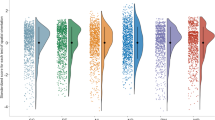Abstract
One hundred and twenty-three spouse pairs gathered as part of a family study of the genetics of special abilities were examined on a battery of ability tests. Four principal components were interpreted after rotation: Spatial, Verbal, Perceptual Speed, and Memory. In addition, the first factor from a common factor analysis (unrotated) was taken as an estimate of g. Assortative marriage was measured by the spouse correlations on the test and factor scores. Three multiple regression models were designed to determine whether phenotypic convergence during marriage occurs and whether resemblance between spouses in cognitive ability is related to fertility. The following independent variables were partialed out in the models: (1) sex and age; (2) sex, age, and length of marriage; and (3) sex, age, and number of children. Model 1 (age and sex) accounted for part of the correlation between spouses on the spatial tests, the verbal tests and the spatial and general factors. The perceptual speed and memory tests and factors were largely unaffected by partialing out the independent variables. No evidence of phenotypic convergence over years of marriage or of a relationship between fertility and resemblance in abilities was found.
Similar content being viewed by others
References
DeFries, J. C., Vandenberg, S. G., McClearn, G. E., Kuse, A. R., Wilson, J. R., Ashton, G. C., and Johnson, R. C. (1974). Near Identity of cognitive structure in two ethnic groups.Science 183:338–339.
French, J. W., Ekstrom, R. B., and Price, L. A. (1963).A Manual for a Kit of Reference Tests for Cognitive Factors, Educational Testing Service, Princeton, N.J.
Garrison, R. J., Anderson, A. E., and Reed, S. C. (1968). Assortative marriage.Eugen. Quart. 15:113–127.
Guttman, L. (1945). A basis for analyzing test-retest reliability.Psychometrika 10:255–282.
Harman, H. H. (1967).Modern Factor Analysis, University of Chicago Press, Chicago.
Jensen, A. R. (1977). Genetic and behavioral effect of nonrandoming mating. In Noble, C. E., and Osborne, R. T. (eds.),Human Variation: Biogenetics of Age, Race and Sex, in press.
Johnson, R. C., DeFries, J. C., Wilson, J. P., McClearn, G. E., Vandenberg, S. G., Ashton, G. C., Mi, M. P., and Rashad, M. N. (1976). Assortative marriage for specific cognitive abilities in two ethnic groups.Hum. Biol. 48:343–352.
Lord, F. M., and Novick, R. M. (1968).Statistical Theories of Mental Test Scores, Addison-Wesley, Reading, Mass., p. 87.
Rotter, J. B. (1966). Generalized expectancies for internal versus external locus of control of reinforcement.Psychol. Monog. 80: Whole No. 609.
Schaefer, E. S. (1958). Development of parental attitude research instrument.Child Dev. 29:339–361.
Schaefer, E. S. (1965). Children's reports on parental behavior: An inventory.Child Dev. 36:413–424.
Schludermann, E., and Schludermann, S. (1970). Replicability of factors in Children's Reports of Parent Behavior (CRPBI).J. Psychol. 76:239–249.
Schludermann, E., and Schludermann, S. (1970a). Conceptualization of maternal behavior.J. Psychol. 75:205–215.
Schludermann, S., and Schludermann, E. (1970b). Conceptual factors of parental attitudes of fathers.J. Psychol. 75:193:204.
Tucker, L. R. (1951). A method for synthesis of factor analysis studies.Personnel Research Section Report No. 964. Department of the Army, Washington, D.C.
Vandenberg, S. G. (1972). Assortative mating, or who marries whom?Behav. Genet. 2:127–157.
Warren, B. L. (1966). A multiple variable approach to the assortative mating phenomenon.Eugen. Quart. 13:285–290.
Wilson, J. R., DeFries, J. C., McClearn, G. E., Vandenberg, S. G., Johnson, R. C., and Rashad, M. N. (1975). Cognitive abilities: Use of family data as a control to assess sex and age differences in two ethnic groups.Int. J. Aging Hum. Dev. 6:215–229.
Author information
Authors and Affiliations
Additional information
This research was supported in part by Research Grant HD06648 to S. G. V. and Training Grant MH11167 to G. E. McClearn.
Rights and permissions
About this article
Cite this article
Zonderman, A.B., Vandenberg, S.G., Spuhler, K.P. et al. Assortative marriage for cognitive abilities. Behav Genet 7, 261–271 (1977). https://doi.org/10.1007/BF01066279
Received:
Accepted:
Issue Date:
DOI: https://doi.org/10.1007/BF01066279




